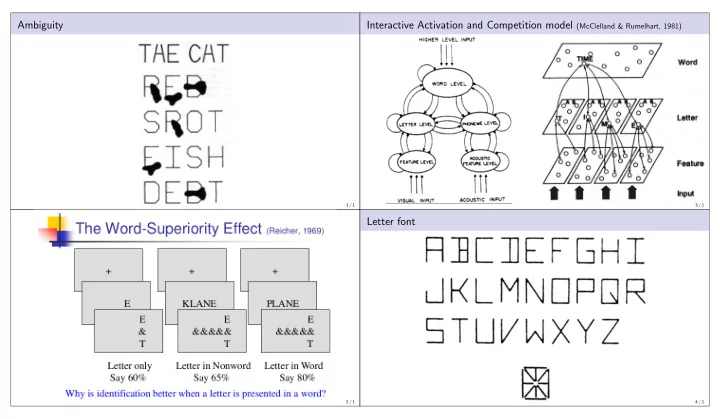

Ambiguity Interactive Activation and Competition model (McClelland & Rumelhart, 1981) 1 / 1 3 / 1 Letter font 2 / 1 4 / 1
Occluded letter features: W O R [R/K] Pseudoword superiority effect 5 / 1 7 / 1 Word superiority effect TRACE model (McClelland & Elman, 1986) 6 / 1 8 / 1
TRACE features, phonemes, words Categorical perception Initial activations Final activations Output probabilities 9 / 1 11 / 1 Phonotactic disambiguation What is the relationship between units and “concepts”? Localist representation: One unit for each concept (one-to-one) Distributed representation: Each concept is coded by many units; each unit participates in coding many concepts (many-to-many) Note that a representation is localist or distributed only with respect to a particular set of concepts or entities. The letter level of the IAC model is localist with respect to letters but distributed with respect to words 10 / 1 12 / 1
Issues with localist representations Schema model Can be difficult to distinguish localist from distributed representations in practice Typically assumes multiple redundant copies (many-to-one) One entity typically partially activates units for other similar entities Schema model: partial activation of other instance units IA letter/word model: partial activation of other word units Similarity effects often driven by degree of overlap within other (distributed) representations Localist representations face a challenge in specifying exactly what it means for something to be one thing (Plaut & McClelland, 2010) Unique experiences? Too many of them.... Unique familiar objects/individuals (“grandmother” cells)? Many objects are novel.... Classes of equivalent experiences? What determines equivalence? 13 / 1 15 / 1 Distributed representations Memory as a constructive process Distribution is always a matter of degree Standard metaphor: Memory as warehouse Sparsity: Number of units that code an entity Perplexity: Degree of dissimilarity among the entities that a given unit codes Reformulation in terms of constraint satisfaction Genuine memory : Pattern that is stable as a result of modifications to weights when Different parts of the brain may use different regions of this space pattern occurred Localist representations are simply one extreme of this space (fully sparse, no perplexity) Confabulation : Pattern that is stable as a result of modifications to weights when other Distributed representations are not alternatives to higher-level cognitive structures (e.g., patterns occurred schemas) but are a flexible way of implementing such structures with useful emergent No sharp distinction (e.g., Bartlett—eyewitness testimony) properties : Constructive Automatic generalization Tunable to changing environments 14 / 1 16 / 1
Recommend
More recommend